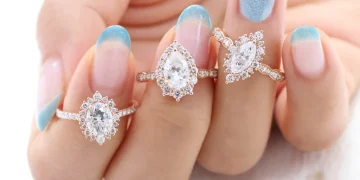In this article, we’ll compare the features and benefits of moissanite vs diamond. These stones are less expensive, lighter, and cleaner than diamonds, but they also differ slightly in value. If you’re considering purchasing one of these two gems for your engagement ring, read on to find out what sets them apart. You’ll be happy you did! And if you’re not sure which is better, check out our guide to Moissanite vs diamond to see which is best for your needs.
Moissanite is cheaper than diamond
There are many reasons to opt for a diamond vs moissanites instead of a diamond. The first is the cost. Diamonds are the most expensive gemstone on the planet, and they are mined in Africa under the most brutal conditions. Furthermore, diamond miners only earn $1 a day, living a very painful lifestyle. However, it’s not a total waste to buy diamonds that are mined in Russia or Canada, which have better ethical standards. Therefore, it makes sense to consider moissanite as an alternative if you’re looking for a diamond that doesn’t have as much heft as diamonds.
Another reason to choose moissanite over diamond is its greater fire and color. Moissanite reflects more light than a diamond. That’s why it has a larger color flash than a diamond. Moissanite also reflects more light, making it visible in sunlight. Finally, despite its lower price, moissanite is an extremely durable gemstone. It registers at 9.25 on the Mohs scale, and as a result, will hold its beauty for a long time.
It is lighter
A moissanite is a synthetic diamond that is created to resemble a diamond. While both diamonds and moissanites are considered to be precious, they are not the same in color and composition. Their light weight and durability make them a good choice for engagement rings and other jewelry, but there are some important differences. In addition to their light weight, moissanites are also cheaper than diamonds.
Despite being significantly lighter than a diamond, they look very similar. The difference between the two is most noticeable in the cut of the stones. Moissanite is cut to minimize double refraction, while diamonds are shaped to maximize sparkle and brilliance. Moissanite is also less dense than diamond, which means that it will weigh less than a diamond of the same carat weight. Moissanite carat weight is always listed next to its diamond counterpart.
It is cleaner
In terms of brilliance, moissanite is a better choice than diamond. The difference lies in the way the stone is cut. While diamonds have strict standards, moissanite is sold by weight. The brilliance of a diamond depends on its cut and size. When a larger stone is used, it can produce a rainbow of colors. Moissanite, on the other hand, is cleaner and more consistent in color.
A meteorite that crashed into the Arizona desert thousands of years ago carried a strewn heap of minerals. In this meteorite, Henri Moissan discovered small particles of moissanite. Usually colorless, moissanite can also have a green tint. This single crystal of silicon carbide is extremely sparkly and gleaming. This makes it a great choice for engagement rings.
It is less valuable
When comparing the two, moissanite is the less expensive option. Its price is generally about 90% less than mined diamonds. Moissanite is also not as scratch-resistant as diamond, but it is less brittle and offers similar durability. While diamonds are king when it comes to durability, moissanite is the more affordable alternative. But what does that mean for those who plan on selling their ring?
Conclusion
The clarity of a gemstone refers to the amount of inclusions or blemishes that are visible in the stone. While diamonds are considered flawless, moissanites are often made in labs and exhibit imperfections. Although moissanites have the same composition and geometry as diamonds, the clarity of their stones varies. Moissanites are cheaper because they lack visible flaws, while diamonds are considered perfect.

















